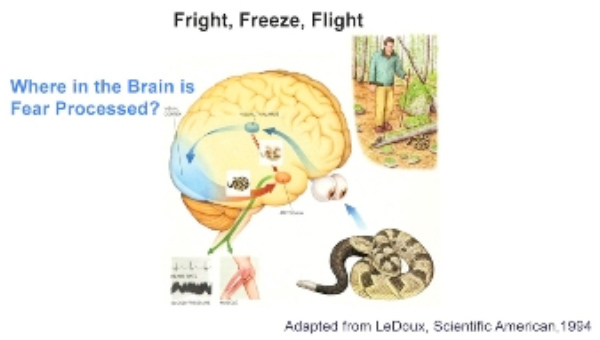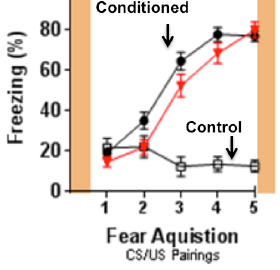We know that oranges can keep you healthy—they are full of vitamins and nutrients that help boost your immune system. But don’t throw away the orange peel just yet. New findings by Cassandra Moshfegh in the laboratory of Dr. Paul Marvar suggest that essential orange oil extracted from the orange peel may help reduce
stress
and
anxiety.
Stress and Stress Disorders
Stress is one way our bodies naturally respond to our external environment. In the short term, normal
physiological
responses to stress include increases in heart rate, breathing rate, metabolism and blood glucose levels and a decrease in the rate of digestion. These changes are caused by hormonal responses catalyzed through the stress response, and they give us added energy to deal with harmful or dangerous situations.

Figure 1. Schematic of the fright, freeze, flight response
Source: https://www.nimh.nih.gov/health/educational-resources/neuroscience-and-psychiatry/neuroscience-and-psychiatry-module-2-fear-safety-anxiety-and-anxiety-disorders.shtml
However, stress is not always a positive force in our lives.
Chronic stress
can affect our bodies and minds in many negative ways, including difficulty sleeping, digestive problems, headaches, lack of energy, aches and pains, frequent sickness, and more. A single stressful or traumatic event can have lasting consequences, including
post-traumatic stress disorder,
known as PTSD.
PTSD may develop in some people who have experienced a traumatic event in their lives. Examples of traumatic events include witnessing or being subjected to violence, abuse, or neglect; witnessing or being involved in an accident or disaster situation; and the loss of a loved one. Each person who has experienced a traumatic event will recover in their own way. For most people, the stress response to the traumatic event will lessen naturally with time. In about 8 percent of the population, however, the stress response may continue to re-occur, even years and decades after the initial traumatic event. PTSD is a broad term used to describe this ongoing psychological and physical stress that may continue years and decades after the initial
traumatic event.
Dr. Paul Marvar, Assistant Professor of
Pharmacology
and Physiology at George Washington University, studies the long-term physiological effects of stress and stress disorders like PTSD. In addition, Dr. Marvar is interested in ways to prevent and reduce these long-term effects. Strategies for reducing the long-term effects of stress may include improving current or developing new drug therapies—but Dr. Marvar emphasizes that non-pharmaceutical approaches and stress reduction techniques are highly beneficial as well. Recent research by his research assistant Cassandra Moshfegh speaks directly to this point.
Experimental Design
Cassandra wanted to know whether natural methods might provide relief from some of the symptoms of PTSD. After looking through the scientific literature on natural remedies for stress, Cassandra identified orange
essential oil
as a promising candidate for her research. She developed a protocol to expose a
mouse model
of PTSD to orange essential oil and measure the effect on the stress response of mice.
The experiment Cassandra developed had two major components: exposure to orange essential oil and
Pavlovian fear conditioning.
Let’s explore each of these elements.
Orange Essential Oil. Essential oils can be consumed in several ways, including direct skin contact, ingestion (eating), and
aroma therapy
(smelling). For this experiment, the researchers delivered the orange oil via olfactory stimulation (smelling). Cassandra soaked a cotton ball in a solution of 25 percent orange essential oil and placed the cotton ball in a
tea infuser,
a metal utensil with holes designed to hold a tea bag. The tea diffuser was then mounted inside each mice cage.
Pavlovian Fear Conditioning. PTSD is a uniquely human psychological disorder that mice do not experience. However, mice can be trained to associate a cue, such as a sound, with a non-harmful stimulus so that they respond fearfully to a non-harmful stimulus in a way that models some components of human PTSD. This process is known as Pavlovian fear conditioning.
Pavlovian fear conditioning works by pairing a non-harmful stimulus, such as a specific sound (audible tone), with an
aversive
or unpleasant stimulus, such as a mild foot-shock or air-puff. The conditioned subject learns to associate the non-harmful stimulus with an aversive response, so that even when the harmful response is removed the subject remains fearful of the stimulus. After the mice have been conditioned to the tone they respond by freezing in place, one way that mice typically respond to fear.

Figure 2. The freezing response observed in orange oil (conditioned) and water-treated (control) mice
The Experiment
The experiment Cassandra designed involved three groups of 12 mice, for a total of 36 mice. The control group was not fear-conditioned and was not exposed to orange essential oil. The water-treated group was fear-conditioned and exposed only to water. The orange-treated group was fear-conditioned and exposed to orange essential oil. In this way, Cassandra was able to compare the fear responses of fear-conditioned mice exposed to orange essential oil and determine if the orange essential oil impacted the fear response.
The experiment took place over five days. On Days 1 and 2, the mice were brought into the test chamber and allowed to adjust to their new surroundings. On Day 3, the two treatment groups were fear conditioned using the process described above. Immediately prior to and following the fear conditioning, the mice were given an acute exposure to their respective interventions: water for the water-treated group and orange essential oil for the orange-treated group. On Days 4 and 5, the fear-conditioned mice were exposed to the tone, and Cassandra recorded the fear or freezing response. This was done using a camera connected to a computer that measured the amount of time the mice froze in response to the tone.
The Findings
At the end of the five-day protocol, it was time to analyze and interpret the results. Cassandra found that the freezing time for the orange-treated mice—indicative of their stress response—was significantly reduced by Day 5, 48 hours after the orange essential oil exposure, compared to the water-treated group. “This was a really surprising result,” Cassandra recalls. “I really wasn’t expecting such a strong reduction in the stress response.”
Given these promising findings, Cassandra next wondered whether exposure to orange essential oil for a longer period of time would further reduce freezing time. To test her hypothesis, Cassandra conducted the same experiment again, but this time the orange-treated mice were exposed to orange essential oil for all five days (and the water-treated group to water for all five days).
In this second experiment, Cassandra found that the orange-treated group that received long-term exposure showed a similar reduction in the freezing time—but this time on Day 4, 24 hours earlier than those that received acute exposure.
To understand what was happening physiologically in the fear-conditioned mice, Cassandra took blood samples and measured the levels of different hormones associated with the stress response as well as changes in immune cells. To her surprise, Cassandra found the stress hormone levels as well as inflammatory immune cell phenotypes were no different between the control and two treatment groups, indicating that the observed differences in fear response were not caused by changes in the stress response or by potential inflammatory cells. “These were very interesting results,” Cassandra commented. “Since the results show that the orange essential oil hasn’t affected the immune system, our next step is to look at gene regulation and expression in the brain.”
For the next set of experiments, Cassandra plans to focus on regions of the brain associated with fear and learning, including the
amygdala
and
pre-frontal cortex.
In addition, Cassandra will look specifically at the expression of two genes: brain-derived neurotrophic factor, associated with stress and healthy nerve growth, and the stress hormone corticotropin-releasing hormone or CRH, which starts the stress response.
Strategies for reducing the long-term effects of stress may include improving current or developing new drug therapies… but non-pharmaceutical approaches and stress reduction techniques are highly beneficial as well.
Cassandra’s findings are supported by other recent research looking at the effects of orange essential oil on stress more generally. For example, a study in Germany found that children exposed to orange essential oil in the dentist’s office—a reliably stressful situation for children—had a lowered heart rate and reduced levels of the stress hormone cortisol compared to children not exposed to the essential oil. “We aren’t sure where this research may lead,” comments Dr. Marvar, “however, additional future research is required to further understand the neurobiological mechanisms of orange oil and the therapeutic implications for stress-related disorders.”
Dr. Paul Marvar is Assistant Professor of Pharmacology and Physiology at George Washington University. His research focuses on the long-term physiological effects of stress disorders, particularly the development of
cardiovascular disease.
When not in the laboratory, Dr. Marvar enjoys cycling, hiking, camping, and spending time with his family.
Cassandra Moshfegh was a research assistant in the laboratory of Dr. Paul Marvar until August 2017. In the Fall 2017, she began graduate school at the University of Nebraska and plans to get her Ph.D. in Biomedical Sciences. When not in the laboratory, Cassandra spends her time volunteering to take care of horses at a therapeutic riding center.
For More Information:
- Moshfegh, C., et al. 2016. “Effects of Essential Oil on Fear Memory and the Immune Response; A Potential Alternative Therapy for Post-Traumatic Stress Disorder (PSTD).” The FASEB Journal, 30: Supplement 1238.5
http://www.fasebj.org/content/30/1_Supplement/1238.5
To Learn More:
Acute and Chronic Stress
- Centers for Disease Control and Prevention.
https://www.nimh.nih.gov/health/topics/post-traumatic-stress-disorder-ptsd/index.shtml
- American Psychological Association.
http://www.apa.org/helpcenter/understanding-chronic-stress.aspx
- Neuroscience and Psychiatry Module 2: Fear/Safety, Anxiety, and Anxiety Disorders.
https://www.nimh.nih.gov/neuroscience-and-psychiatry-module2/index.html
Post-Traumatic Stress Disorder
- National Institutes of Mental Health.
https://www.nimh.nih.gov/health/topics/post-traumatic-stress-disorder-ptsd/index.shtml
- American Psychiatric Association.
https://www.psychiatry.org/patients-families/ptsd/what-is-ptsd
- American Psychological Association.
http://www.apa.org/topics/ptsd/
- U.S. Department of Veterans Affairs.
https://www.ptsd.va.gov/public/ptsd-overview/basics/what-is-ptsd.asp
Written by Rebecca Kranz with Andrea Gwosdow, PhD at www.gwosdow.com

